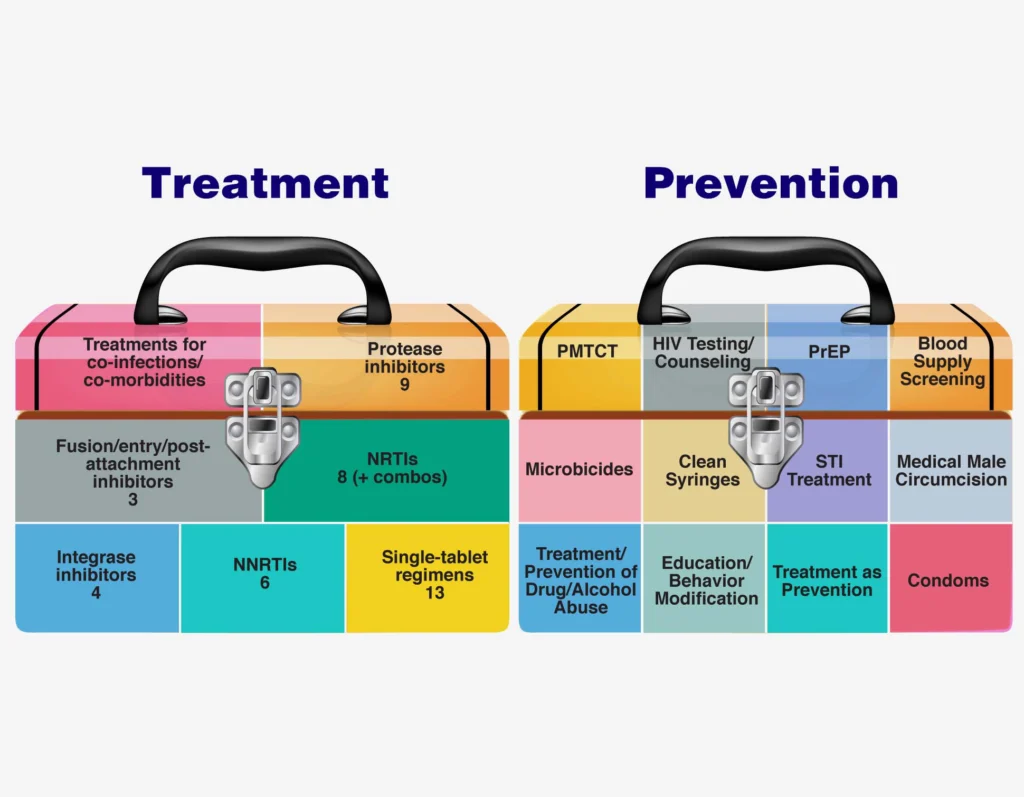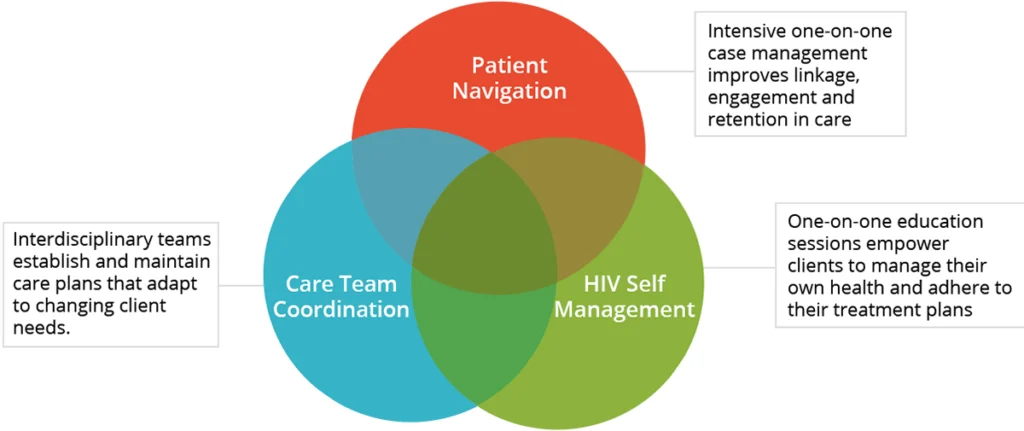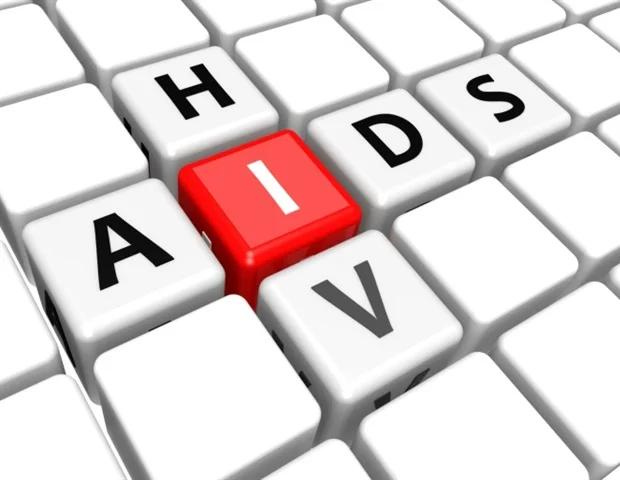Acquired Immunodeficiency Syndrome (AIDS) is a serious medical condition caused by the Human Immunodeficiency Virus (HIV) that weakens the immune system, leaving individuals vulnerable to life-threatening infections and cancers. HIV targets CD4 T cells, crucial for fighting infections. Untreated HIV progresses through three stages, with the final stage being AIDS.
Understanding HIV and AIDS
HIV spreads through bodily fluids like blood, semen, vaginal secretions, and breast milk. It is not spread through casual contact like hugging or sharing food. The virus spreads through unprotected sex, needle sharing, mother-to-child transmission during pregnancy or breastfeeding, and contaminated blood products. Early diagnosis through testing is crucial, as HIV can remain asymptomatic for years, making it essential to get tested to prevent transmission and start treatment promptly.
Progression of HIV Infection
- Stage 1 – Acute Infection: This initial stage involves high levels of HIV in the blood, flu-like symptoms, and high transmissibility.
- Stage 2 – Chronic Infection: HIV is still active but replicates at a slower rate. Some individuals may not exhibit symptoms but can still transmit the virus.
- Stage 3 – AIDS: the most severe stage where the immune system is significantly compromised, leading to opportunistic infections and serious illnesses. Without treatment, individuals with AIDS typically survive for about three years.
Origins and History
It was first recognized in the early 1980s, initially baffling medical professionals due to its mysterious and rapid progression. Over time, extensive research has uncovered the viral origin and transmission routes of HIV. Understanding the historical context of AIDS aids in appreciating the evolution of treatments and prevention strategies.
Symptoms and Progression
HIV Symptoms
- Acute Infection Stage (Primary HIV Infection):
- Fever
- Headache
- Fatigue
- Aching muscles
- Sore throat
- Swollen lymph nodes
- Red rash that doesn’t itch
- Ulcers in the mouth, esophagus, anus, or genitals.
- Chronic Infection Stage (Asymptomatic HIV Infection):
- Many individuals may not experience noticeable symptoms
- Progressive weakening of the immune system without apparent signs.
AIDS Symptoms
- Advanced Stage (AIDS):
- Rapid weight loss
- Recurring fever or profuse night sweats
- Extreme and unexplained tiredness
- Prolonged swelling of lymph glands
- Diarrhea lasting more than a week
- Sores in the mouth, anus, or genitals
- Pneumonia
- Skin blotches or lesions
- Memory loss, depression, and other neurological disorders.
It’s important to note that these symptoms can also be related to other illnesses, and the only way to confirm HIV infection is through testing. Early diagnosis and treatment are crucial in managing HIV and preventing progression to AIDS. If you suspect exposure to HIV or experience any of these symptoms, seeking medical advice and testing is essential for timely intervention and care.
Transmission Dynamics
Explore the various modes of HIV transmission, from unprotected sexual contact to intravenous drug use and mother-to-child transmission. Gain insights into the factors influencing transmission rates and strategies for mitigating the spread of the virus.
For more Health information, read: Why Viruses Are Considered Nonliving
Prevention Strategies
To prevent HIV and AIDS, several key strategies can be implemented based on the information provided in the sources:
- Safe Sex Practices:
- Consistent and correct use of condoms during sexual activity significantly reduces the risk of HIV transmission.
- Choosing sexual partners wisely and considering monogamous relationships can lower the chances of contracting or transmitting HIV.
- Regular Testing and Treatment:
- Regular testing for HIV and other sexually transmitted infections (STIs) is essential to stay informed about one’s health status and reduce transmission risks.
- Early diagnosis and immediate linkage to antiretroviral treatment (ART) can prevent the progression of HIV to AIDS and reduce the risk of transmission.
- Needle Safety:
- Avoid sharing needles or injecting equipment to prevent exposure to HIV and other blood-borne infections.
- Use sterilized needles and participate in needle exchange programs to reduce the risk of contracting HIV through injection drug use.
- Medication-Based Prevention:
- Pre-exposure prophylaxis (PrEP) is a daily medication that can lower the risk of contracting HIV, especially for individuals at high risk of infection.
- Post-exposure prophylaxis (PEP) is available for individuals concerned about HIV transmission after potential exposure and should be initiated within 72 hours of the encounter.
- Education and Awareness:
- Understanding how HIV is transmitted and implementing preventive measures is crucial in reducing the spread of the virus.
- Open communication about HIV status with sexual partners, regular testing, and treatment adherence are key components of prevention efforts.
By combining these preventive measures, individuals can significantly reduce the risk of HIV transmission, protect their health, and contribute to the overall prevention of HIV and AIDS within communities.
Diagnosis and Testing
Based on the provided sources, the diagnosis and testing of HIV involve several key aspects:
- Diagnostic Tests:
- HIV diagnostic testing has evolved significantly, with current enzyme immunoassays being sensitive enough to detect antibodies within one to two weeks after infection.
- Various assays like Western blot, polymerase chain reaction (PCR), and p24 antigen testing are used to confirm positive antibody screens, provide additional information, and ensure accurate laboratory diagnosis.
- Point of Care tests offer rapid on-site HIV results but require adherence to quality control practices and confirmation by a licensed diagnostic laboratory.
- Testing Recommendations:
- Early diagnosis of HIV infection is crucial for better treatment outcomes and reducing transmission risks.
- Individuals at risk, including men who have sex with men and black African men and women, are advised to test regularly for HIV and other sexually transmitted infections.
- Testing is recommended for anyone who suspects exposure to HIV, with guidelines suggesting annual testing for some groups and more frequent testing for high-risk individuals.
- Types of Tests:
- HIV testing can be done through blood tests in a clinical setting, which have shorter window periods and can detect HIV more quickly compared to other tests.
- Point of care tests using saliva samples provide rapid results within minutes, while home sampling and home testing kits are also available for convenience.
- It is essential to confirm positive test results with a blood test in a clinical setting to ensure accuracy and appropriate follow-up care
Treatment Approaches
Based on the provided sources, there are several treatment approaches for HIV infection, including the use of antiretroviral therapy (ART) and the development of new treatment options. Here are the key treatment approaches outlined in the sources:
- Antiretroviral Therapy (ART):
- ART is considered the most effective treatment for HIV/AIDS, involving a combination of several antiretroviral medicines that work to control the virus in the body.
- The goal of ART is to suppress the amount of virus in the body, allowing the immune system to repair itself and prevent further damage caused by HIV.
- Individuals with HIV are recommended to start ART as soon as possible after diagnosis to achieve viral suppression and maintain long-term health.
- Combination Therapy:
- Combination therapy involves using multiple HIV medicines from different drug classes to create an effective treatment regimen that targets various stages of the virus life cycle.
- Taking a combination of medicines reduces the likelihood of developing drug resistance and enhances the effectiveness of treatment in controlling HIV replication.
- New Treatment Approaches:
- Ongoing research is exploring new treatment options for HIV, including neutralizing antibodies, genome editing, and strategies to block integrated latent provirus.
- These innovative approaches aim to address challenges such as viral resistance to current medications and offer promising alternatives for future HIV treatment.
- Preventive Measures:
- Post-exposure prophylaxis (PEP) is available for individuals who may have been exposed to HIV, providing emergency medication within 72 hours to prevent infection.
- Regular testing, early diagnosis, and adherence to treatment are essential components of preventing disease progression and reducing transmission risks associated with HIV infection

Addressing Stigma and Discrimination
Examine the pervasive stigma and discrimination associated with HIV and its impact on individuals living with the disease. Explore strategies for fostering inclusivity, empathy, and support within communities affected by it.
Empowering Communities
Highlight initiatives aimed at empowering marginalized communities disproportionately affected by HIV. From promoting access to healthcare services to advocating for comprehensive sex education, explore avenues for promoting health equity and social justice.
Research and Innovation
Explore the latest advancements in HIV/AIDS research, from vaccine development to novel treatment modalities. Explore promising avenues for achieving breakthroughs in HIV prevention and cure efforts.
Global Impact and Challenges
Assess the global impact of HIV and the persistent challenges in achieving epidemic control. Explore disparities in access to healthcare services and the socio-economic determinants influencing HIV/AIDS outcomes worldwide.
Partnering for Progress
Highlight the importance of collaboration among governments, NGOs, healthcare providers, and affected communities in the global response to HIV/AIDS. Emphasize the collective effort required to address the multifaceted challenges posed by the epidemic.
Beyond AIDS: Looking to the Future
Explore the trajectory of HIV/AIDS research and interventions in the context of evolving public health priorities. Discuss the potential for leveraging lessons learned from the HIV response to address emerging infectious diseases and global health threats.
Bridging Communities, Building Resilience
In this concluding section, reflect on the enduring impact of HIV on individuals, families, and societies worldwide. Emphasize the importance of compassion, solidarity, and collective action in confronting the challenges posed by AIDS and fostering a healthier, more equitable world.

FAQs
What is AIDS?
Acquired Immunodeficiency Syndrome, is a chronic, potentially life-threatening condition caused by the human immunodeficiency virus (HIV). It weakens the immune system, making individuals more susceptible to infections and other complications.
How is HIV transmitted?
HIV can be transmitted through unprotected sexual contact, sharing contaminated needles or syringes, and from mother to child during childbirth or breastfeeding. It is important to practice safe sex and avoid sharing needles to prevent HIV transmission.
Is there a cure for AIDS?
While there is currently no cure for AIDS, advancements in antiretroviral therapy (ART) have transformed HIV into a manageable chronic condition for many individuals. Early diagnosis and access to treatment are critical for managing the disease effectively.
What are the symptoms of AIDS?
The symptoms of AIDS can vary widely and may include fever, fatigue, weight loss, recurrent infections, and skin rashes. However, it’s important to note that individuals infected with HIV may not develop AIDS for many years, especially with proper treatment.
How can stigma and discrimination against people living with AIDS be addressed?
Addressing stigma and discrimination requires a multi-faceted approach involving education, advocacy, and policy reforms. Promoting empathy, understanding, and acceptance within communities is essential for creating supportive environments for individuals affected by HIV.
What role can communities play in the fight against AIDS?
Communities play a crucial role in the fight against AIDS by promoting awareness, providing support services, and advocating for policies that prioritize HIV prevention and treatment. Engaging affected communities in decision-making processes is key to developing effective and sustainable HIV/AIDS interventions.
Conclusion
In conclusion, AIDS remains a significant public health challenge with far-reaching implications for global health and well-being. By fostering collaboration, innovation, and compassion, we can overcome barriers to HIV/AIDS prevention, treatment, and support, ultimately striving toward a world free from the burden of AIDS.

